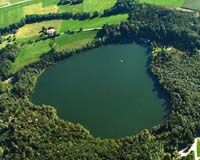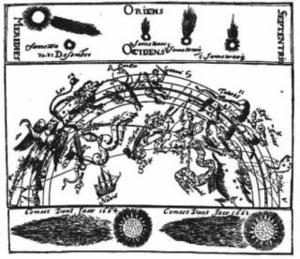
|
| ©Unknown
|
| Cometary fire ruins, as seen from the corner of Dearborn and Monroe Streets, Chicago, 1871.
|
Last night we watched
Super Comet - After the Impact, a Discovery Channel special that basically takes
the comet that wiped out the dinosaurs and put into modern times. They added some cheesy drama, following the struggles of several individuals or groups, before, during, and after the impact, to show how people would react to such a global cataclysm. They used the same type of cometary body assumed to have caused the extinction of the dinosaurs, the same size, same impact location, and utilized all the computer modeling they have done on this past event to try to show what might happen (and to show what they think happened then). Not terribly creative and suggests that they really don't know all the effects of such an impact and are just putting things together from what little they have been able to figure out about that one impact, some (or much) of which may be just speculation, though I'm sure that there is some good science going on there.
This show highlights what we have already noted in this series of articles: the difference between the American School of Asteroid impacts that happen only at millions of years intervals and the British School which posits that showers of much smaller objects occur with great frequency in between those millions of years events.
The cheesiest part of this "docu-drama" was, of course, the depicted foibles of the humans experiencing the event. But, in a way, even those depictions were useful. The one guy who simply couldn't grasp the nature of the event, kept traveling "home" (which happened to be the site of the impact) even when it was clear that there was no home left. His emotions basically drove him to his own death.
Other people continued to act as if the world was still the same place and suffered thereby, though they learned to cope. What was clearly evident was that it was lack of knowledge about such events that was the chief problem for all of them.
During the course of the show, one of the experts made the remark "WHEN it happens," as though he - and the rest of them - knew for a fact that this was on the agenda for our near future. The very fact that so many scientists are working on these problems, including a large number of them studying the possible human reactions and behaviors and how to deal with masses of people, should warn us that there IS something they aren't telling the masses in the headlines of our daily newspapers, though certainly they are "testing" public reactions with shows such as
Super Comet - After the Impact.
On my desk, before me, I have a book out of the more than 30 volumes and scores of papers on the topic of comet and asteroid impacts that I have collected in the course of this study. The title of this book is
Hazards due to Comets and Asteroids edited by Tom Gehrels, with 120 contributing authors, published by the University of Arizona Press in 1994.
There is something in this book that I want to bring to your attention before we get on to our main catastrophe of the day: Mrs. O'Leary's Cometary Cow.




Comment: Continue to Part Seven: Tunguska, the Horns of the Moon and Evolution